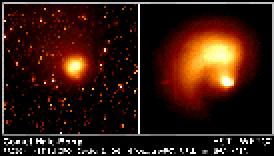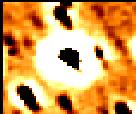Material Ejected from Comet Hale-Bopp
Recent pictures from NASA's Hubble Space Telescope show a distinguishable spiral "pinwheel" pattern and a "blob" of free-flying rubble near the comet's nucleus. A bright accumulation of light along the spiral is believed to be a piece of the comet's icy crust that was ejected due to ice evaporation and the comet's own rotation.
Comet Hale-Bopp may become the brightest comet in 1997 even though the comet is still well outside the orbit of Jupiter (approximately 600 million miles away from the Earth). Observations taken from the HST will aid scientists in determining whether or not Hale-Bopp is really a giant comet or rather a more moderate-sized object whose current activity is driven by outgassing from very volatile ice which will "burn out" over the next year. More detailed Hubble images will be taken with the Planetary Camera late this month to follow the evolution of the spiral as well as to search for more outbursts, place limits on the size of the nucleus, and to use spectroscopy to study the comet's chemical composition.
The spiral pattern made by the debris ejecting from Hale-Bopp occurs because the solid nucleus rotates like a lawn sprinkler, with one complete rotation about once a week. Observations made from the ground show two other incidents of of the spiral formation, both of which faded. The first images of Hale-Bopp (Septembe 26) show a clear separation between the nucleus and the debris being ejected. Recent observations made from the Teide Observatory in Spain enabled astronomers to determine that the debris is leaving the nucleus at 68 miles per hour.

Observers: Ricard Casas, Luis Chinarro, Angel Gomez, Luis Manade, antiago Lopez, and Miquel Serra-Ricart
Location: Teide Observatory, Canary Islands, Spain
Date: October 22, 1995
Images of Hale-Bopp may be accessed from the Comet Hale-Bopp Home Page at http://newproducts.jpl.nasa.gov/comet/, and also via anonymous ftp from ftp.stsci.edu in /pubinfo. Other sites providing images are http:www.stsci.eupubinfo/Latest.html and http://www.stsci.edu/pubinfo/Pictures.html.






